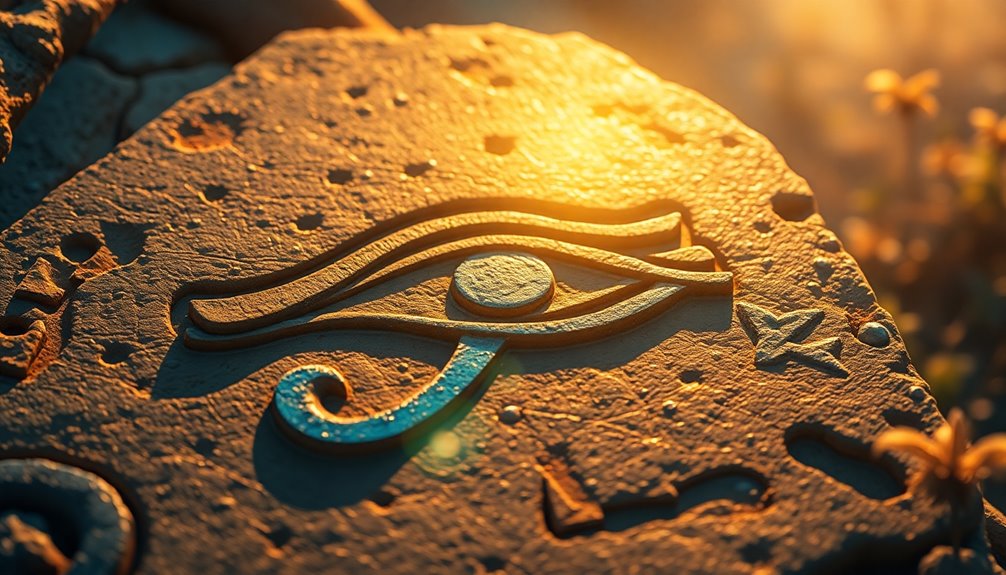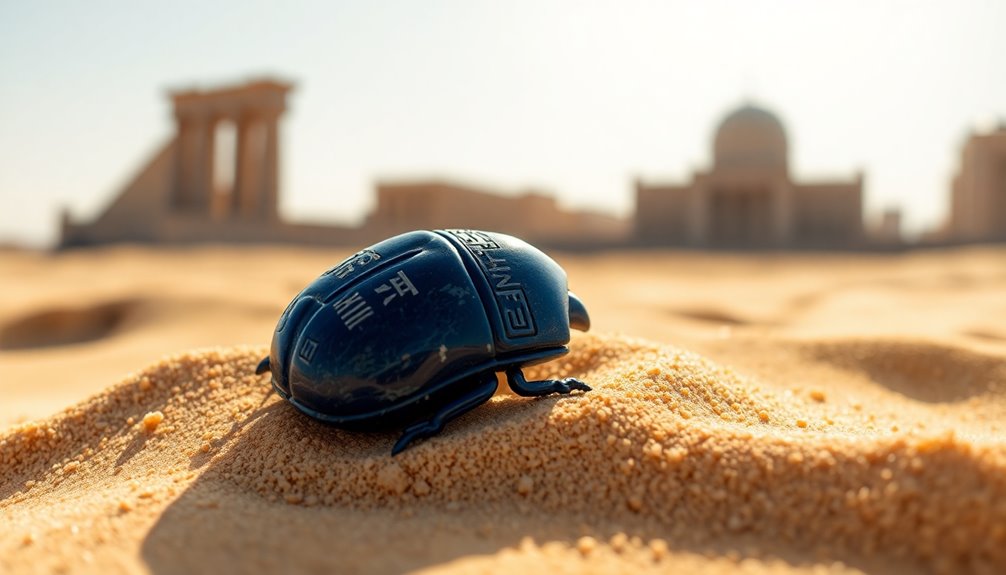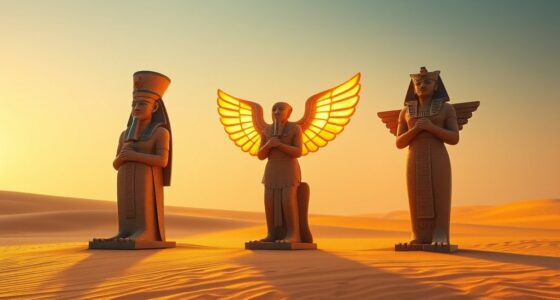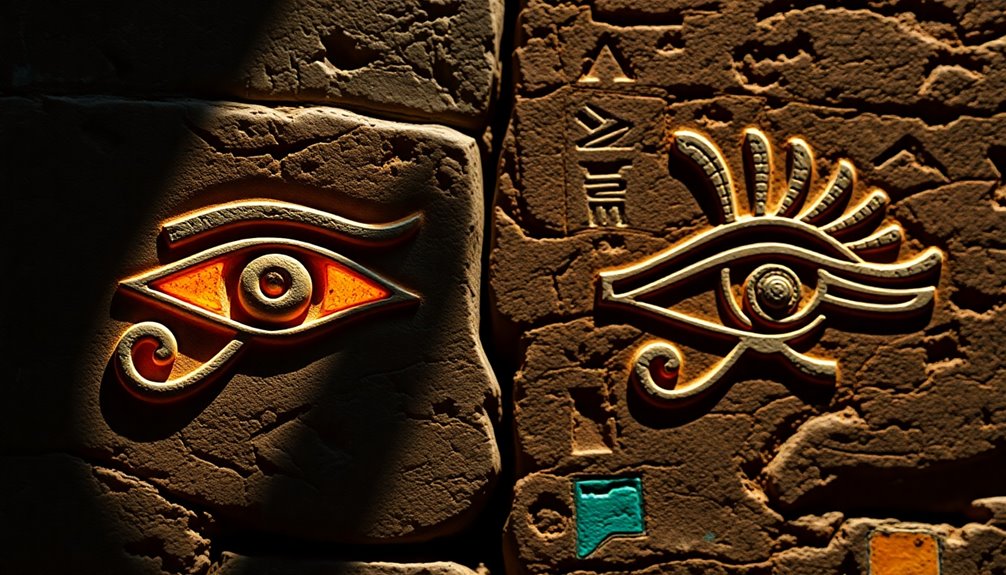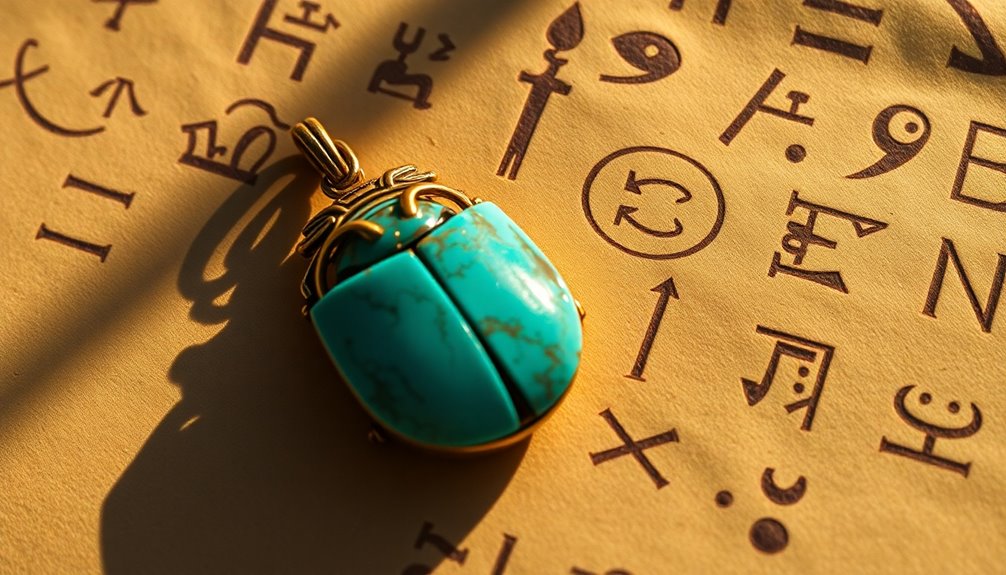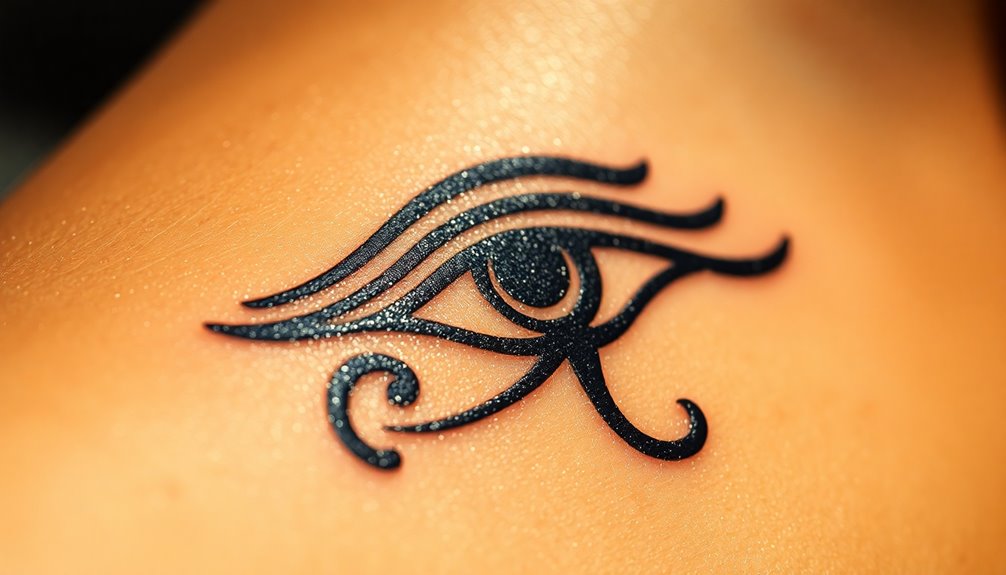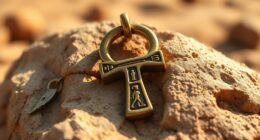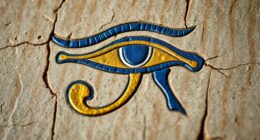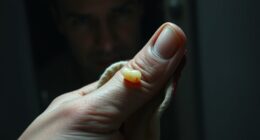The Eye of Ra symbol connects you to ancient Egyptian beliefs about protection, power, and creation. Representing the sun god Ra's right eye, it stands for truth and vigilance, protecting you from chaos and evil. With ties to nurturing goddesses and the cycles of life, this symbol embodies both nurturing and wrathful aspects. It historically empowered pharaohs and shaped moral values, emphasizing balance and justice. Now, many embrace its significance in personal growth and modern spirituality. Discover how this ancient symbol can enhance your life even further as you explore its rich history and influence.
Key Takeaways
- The Eye of Ra represents powerful protection against chaos and evil, enhancing your sense of security in daily life.
- Its symbolism of justice and truth encourages personal integrity and moral balance in your actions and decisions.
- Embracing the Eye's nurturing aspects can inspire personal growth and renewal, fostering resilience amidst challenges.
- The Eye's connection to divine authority empowers you to pursue your goals with confidence and determination.
- Incorporating the Eye of Ra in your life can enrich your spiritual journey, linking you to ancient wisdom and cultural heritage.
What Is the Eye of Ra?
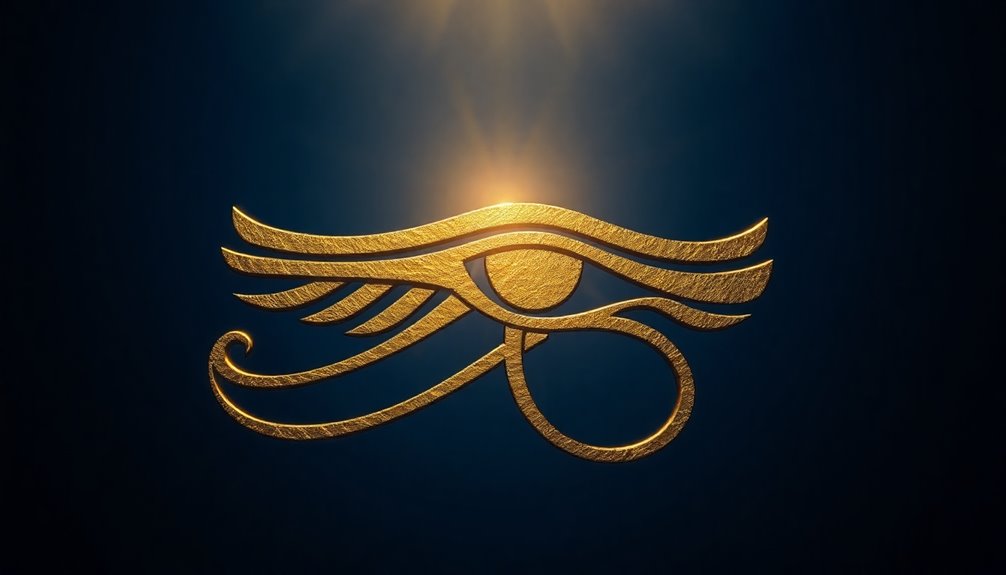
The Eye of Ra symbolizes ancient Egyptian beliefs about protection and power. Representing the right eye of the sun god Ra, this ancient Egyptian symbol is often depicted as a human eye with a teardrop, signifying water and fertility.
You might find it fascinating that the Eye of Ra is closely associated with several goddesses, including Hathor, Sekhmet, and Bastet. Each embodies distinct feminine roles, such as mother, consort, and protector of Ra, enhancing its importance in Egyptian mythology.
Considered the "eye of truth," the Eye of Ra possesses the ability to see everything without exception. This unique trait makes it a powerful symbol of protection against chaos and evil.
When you think of the Eye of Ra, it's also linked to the ankh, which symbolizes life and immortality. This connection highlights the destructive power of the sun and its crucial role in agriculture and existence.
Over time, the Eye of Ra has evolved in meaning, showcasing its cultural significance and distinctiveness, especially when compared to other symbols like the Evil Eye, which has entirely different origins.
Origins and Myths
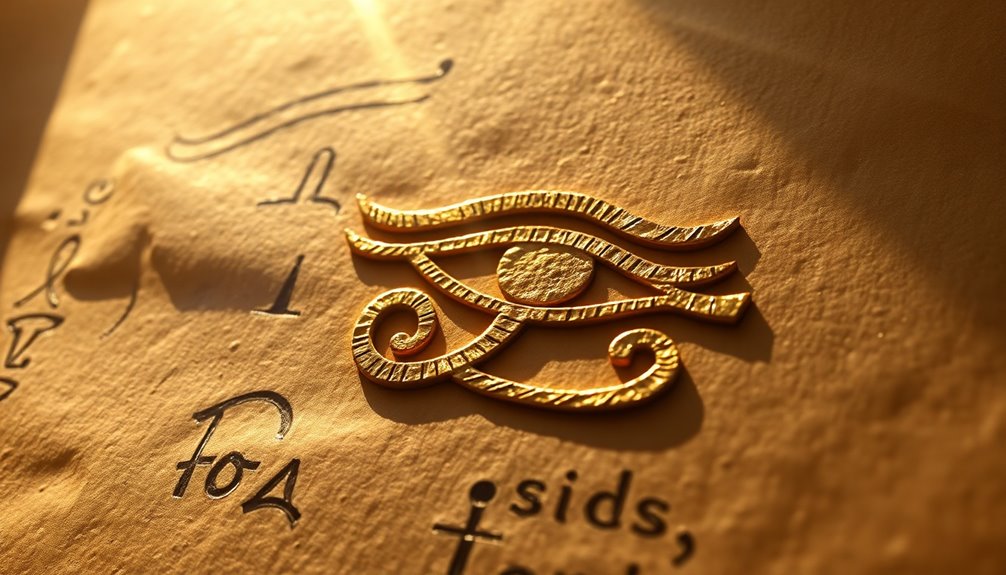
When you explore the origins and myths surrounding the Eye of Ra, you'll discover a rich tapestry of stories about Ra's children, Shu and Tefnut.
These myths not only highlight the Eye's journey to bring them back but also showcase its fierce nature when provoked.
As you uncover these narratives, you'll see how the Eye transforms from a protector to an avenger, embodying both nurturing and aggressive qualities.
Ra's Children: Shu and Tefnut
Often regarded as pivotal figures in ancient Egyptian mythology, Shu and Tefnut are the children of Ra, the sun god. Created from Ra's own essence, they embody the elements essential for life—air and moisture. Their journey into the waters of Nun highlights their divine origins and the strong link to Ra. When they wandered away, Ra sent the Eye of Ra to locate them, showcasing its protective role within the cosmic order.
The successful return of Shu and Tefnut to Ra was marked by his tears, believed to have birthed the first humans. This act emphasizes the interconnectedness of creation and the divine in Egyptian mythology. Additionally, the myths reveal the Eye of Ra's anger when it discovered a new eye had emerged during its absence, transforming it into a fierce protector against threats to Ra's reign.
| Element | Description |
|---|---|
| Shu | God of air |
| Tefnut | Goddess of moisture |
| Eye of Ra | Protective force |
| Creation | Birth of humanity |
These narratives reflect themes of familial bonds, the Eye of Ra's power, and the cyclical nature of existence.
The Eye's Return Journey
Ra's concern for his children, Shu and Tefnut, propelled the Eye of Ra on a pivotal journey through the waters of Nun. As a powerful entity in Egyptian mythology, the Eye searched tirelessly to locate her lost siblings. Upon finding them, the Eye of Ra successfully facilitated their return journey to their father, reinforcing her role as a protector of the divine family.
This reunion wasn't just significant for Ra; it marked a moment of profound creation. Myths recount that Ra's tears shed in joy upon reuniting with Shu and Tefnut led to the emergence of the first humans. This highlights the Eye's deep connection to both nurturing and the act of creation itself.
However, the story takes a twist when the Eye discovers a new entity has replaced her, igniting her volatile nature. To appease her fury and restore balance, Ra grants the Eye the status of the uraeus, a symbol of sovereignty that underscores her power in ancient Egyptian culture.
Consequently, the Eye of Ra embodies not only protection and creation but also the complexities of authority and independence.
Anger and Transformation Myths
The Eye of Ra's myths reveal a fascinating interplay of anger and transformation, showcasing how this powerful symbol evolves in response to emotional turmoil.
One key narrative involves Ra's search for his lost children, Shu and Tefnut. When he discovered a new eye had been created, Ra's anger ignited, leading to the Eye's transformation into the uraeus on Ra's forehead, symbolizing immense power and sovereignty. This transformation can be likened to the essential oils for toothache relief, which provide various methods to alleviate pain and promote healing.
In the myth of the Destruction of Humankind, the Eye of Ra is identified as Hathor, who transforms into the fierce goddess Sekhmet to punish humans for their rebellion. This volatile nature highlights the Eye's destructive power.
Yet, Ra's emotional response to humanity's plight adds depth; his tears are said to have created humans, illustrating the Eye's nurturing side.
Myths surrounding the Eye emphasize its aggressive tendencies, often pacified by Ra using red beer, signifying a transformation from wrath to tranquility.
Consequently, the Eye of Ra embodies a complex duality, illustrating how anger can lead to fierce punishment or transformative nurturing, forever altering the fabric of existence. Additionally, the symbolism of the Eye of Ra parallels the calming effects of aromatherapy techniques, which can also help in managing emotional turbulence.
Symbolism and Significance
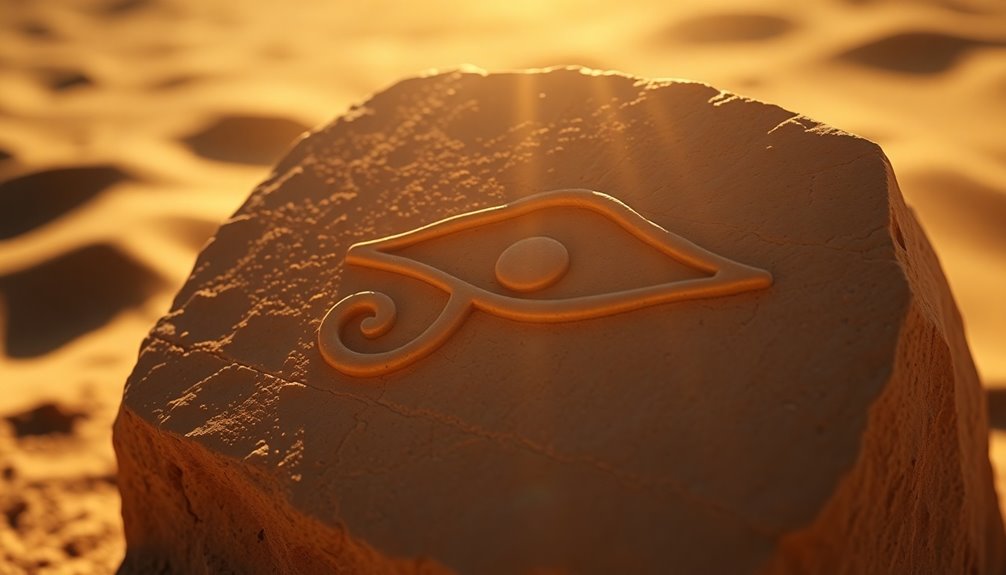
When you explore the Eye of Ra, you'll discover its protective powers that guard against chaos and wrongdoing.
This symbol also embodies feminine divine attributes, emphasizing the nurturing aspects of the sun.
Additionally, it serves as a powerful representation of justice, linking the gods' authority with the principles of truth and balance.
Protective Powers of Ra
Throughout ancient Egyptian culture, the Eye of Ra emerged as a powerful emblem of protection, believed to ward off negative energies and chaos. This symbol wasn't just decorative; it played an essential role in the lives of Pharaohs, who invoked the Eye of Ra for personal safety and to reinforce their royal authority.
By wearing amulets or crowning themselves with the uraeus—a representation of the Eye of Ra as a cobra—they sought divine protection against enemies and disorder.
Rituals celebrating the Eye of Ra, particularly during the New Year and Nile flood, emphasized its significance in ensuring agricultural fertility and community well-being.
The Eye's protective powers extended beyond life, as funerary texts linked it to the afterlife. In this domain, it was believed to guide and safeguard souls traversing the Duat, the Egyptian underworld.
Feminine Divine Attributes
Many ancient Egyptian symbols embody feminine divine attributes, and the Eye of Ra stands out as a significant representation. This powerful symbol encapsulates the essence of femininity, blending protection and nurturing qualities. In ancient Egyptian theology, the Eye of Ra symbolizes the duality of strength and care associated with motherhood, showcasing the role of women in the cosmic order.
| Attribute | Significance |
|---|---|
| Protection | Safeguarding the pharaoh and society |
| Nurturing Qualities | Emphasizing the importance of fertility and life |
| Maternal Figure | Representing the cycle of life and rebirth |
| Creation | Highlighting the creative force of femininity |
| Cosmic Order | Maintaining balance in the universe |
Goddesses like Hathor, Sekhmet, and Bastet embody the Eye of Ra's characteristics, illustrating love, war, and domesticity. When invoked in rituals, the Eye serves as a maternal figure, reinforcing its connection to creation and protection. The symbolism of the Eye of Ra, often depicted with a teardrop, evokes water and fertility, further linking women to both the nurturing and creative aspects of life in ancient Egyptian mythology.
Symbol of Justice
The Eye of Ra, often called the "eye of truth," represents a powerful symbol of justice in ancient Egyptian culture. This emblem embodies the essence of vigilance, acting as a guardian against evil and ensuring that wrongdoings are observed and punished.
You can see how its connection to the sun's life-giving power highlights its role in maintaining order and balance in society, a vital aspect of both personal and communal justice.
- It symbolizes protection against the forces of chaos.
- The Eye serves as a reminder of the divine justice system, where every action has consequences.
- Its teardrop signifies the restorative aspects of justice, promoting themes of renewal and balance.
In ancient Egyptian religion, the Eye of Ra was placed above doorways, symbolizing omnipresence and the relentless pursuit of truth.
Myths surrounding it emphasize its dual nature as both protector and avenger, reinforcing its importance in ensuring justice prevails.
Once you recognize the Eye of Ra as a symbol of justice, you'll begin to understand its profound significance in shaping moral and ethical values in a society deeply rooted in ancient traditions.
Roles of the Eye of Ra
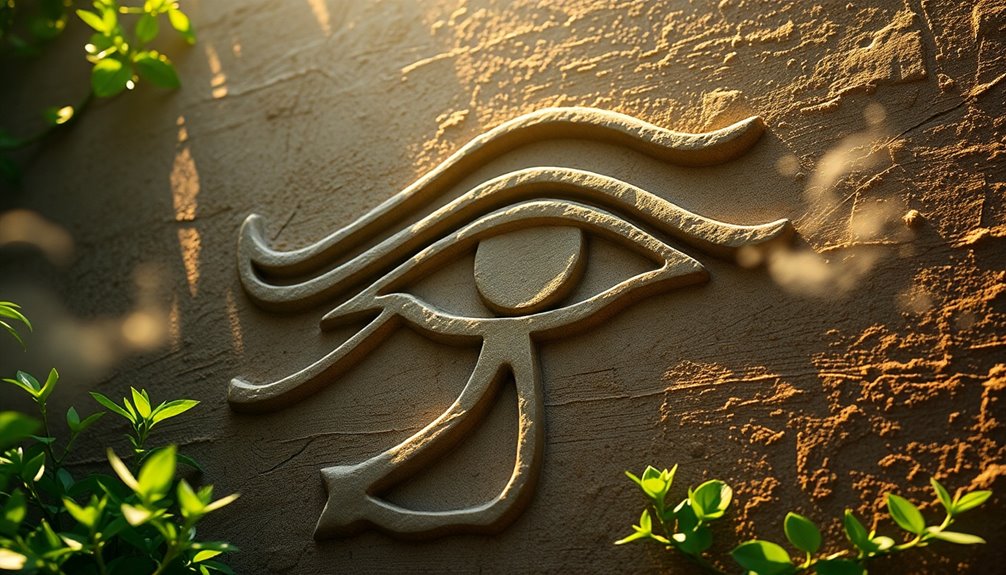
In ancient Egyptian mythology, the Eye of Ra plays an essential role as a protective deity, embodying both nurturing and destructive qualities. This duality is vital, as the Eye guards against chaos and punishes evildoers. It's often depicted in Egyptian art alongside goddesses like Hathor, Sekhmet, and Bastet, showcasing its roles as mother, sister, consort, and daughter of Ra.
| Role | Description |
|---|---|
| Protector | Guards against chaos and evil. |
| Nurturer | Associated with creation and agricultural renewal. |
| Royal Power | Symbol of strength for pharaohs, often seen as a cobra (uraeus). |
| Divine Connection | Linked to Ra's tears that formed humanity. |
The Eye of Ra isn't just a symbol; it's a powerful emblem of royal power. Pharaohs invoked this Eye for protection and strength, highlighting its importance in leadership. Celebrated during festivals marking the Nile inundation, the Eye of Ra emphasizes its significance in both divine protection and agricultural rejuvenation. Understanding these roles helps you appreciate its profound impact on ancient Egyptian culture.
Worship Practices
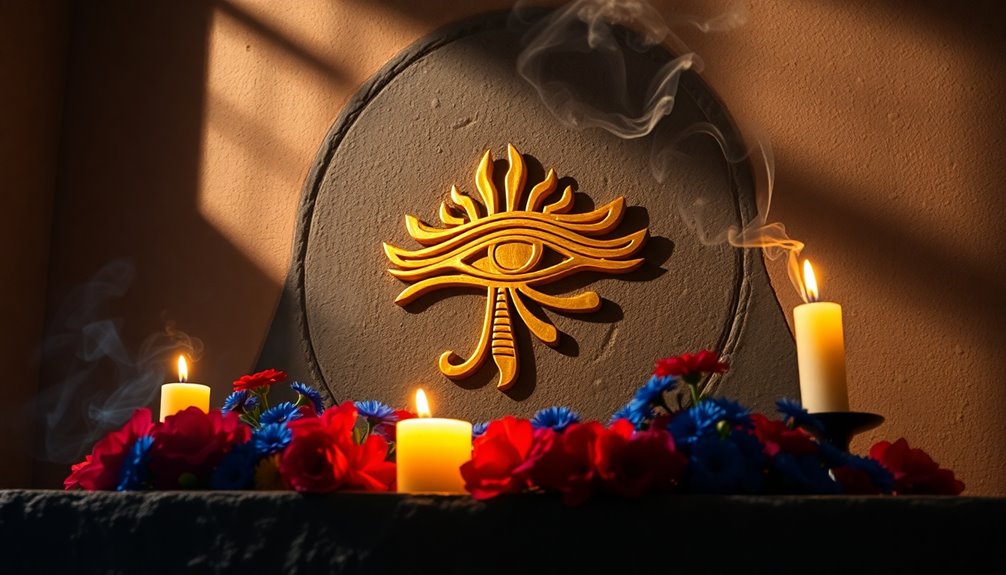
Worship practices surrounding the Eye of Ra were deeply intertwined with the rhythms of ancient Egyptian life, especially during significant events like the New Year and the Nile flood.
These rituals symbolized renewal and fertility, emphasizing the Eye's role in maintaining cosmic order. Temples along the Nile, adorned with images dedicated to the Eye, were the focal points for annual festivals celebrating the goddess's return.
During these ceremonies, you'd witness:
- Rituals for Renewal: Participants engaged in ceremonies that marked the rebirth of nature and the flooding of the Nile, essential for agriculture.
- Protection Offerings: Devotees invoked the Eye of Ra to safeguard against darkness and danger, reinforcing its role as a powerful protector in daily life and the afterlife.
- Pharaohs' Invocation: Pharaohs frequently called upon the Eye for strength and protection, reflecting its integral place in royal ideology.
These practices not only honored the Eye of Ra but also reinforced the societal values of the ancient Egyptians, ensuring their connection to the divine and the natural world.
Eye of Ra in Modern Culture
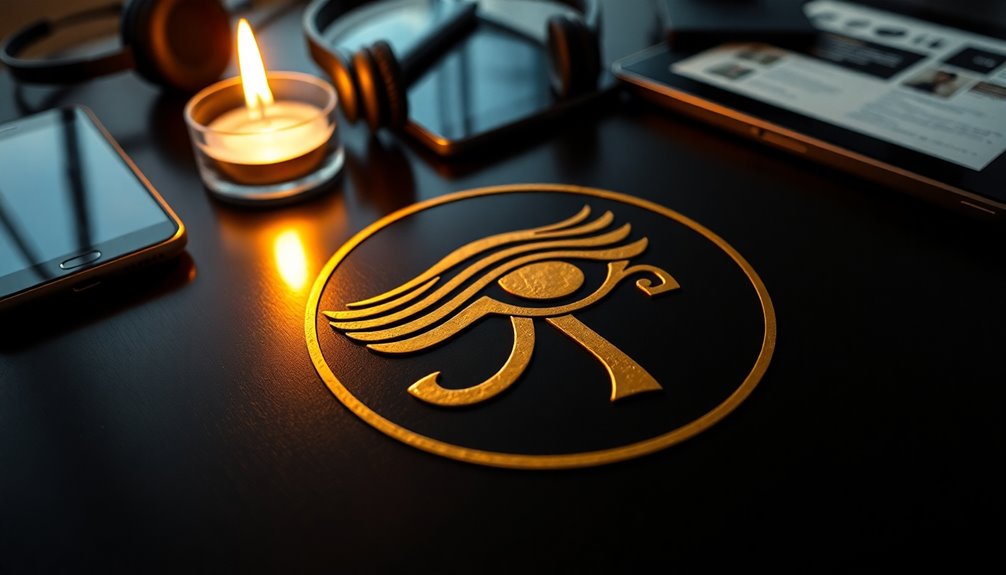
Rooted in ancient traditions, the Eye of Ra has found a vibrant place in modern culture, where it symbolizes protection, strength, and good fortune. You'll notice this powerful emblem in jewelry and tattoos, as people embrace its historical significance.
Many contemporary spiritual practices incorporate the Eye of Ra, linking it to personal growth and transformation, awakening a sense of enlightenment within individuals like you.
In modern culture, the Eye of Ra manifests in various art forms, from graphic design to fashion, showcasing a renewed interest in ancient Egyptian symbolism. You may also encounter it in popular media, where it often represents themes of power and mystery, adding depth to stories in movies, video games, and literature.
What's fascinating is the modern interpretation emphasizing the Eye of Ra's dual nature. It reflects both a nurturing and destructive force, resonating with your understanding of balance and duality in life.
As you explore this symbol, you might find that it not only connects you to ancient Egyptians but also serves as a guiding force in your journey toward self-discovery and empowerment.
Frequently Asked Questions
What Does It Mean if You See the Eye of Ra?
If you see the Eye of Ra, it might signify protection and guidance in your life.
This powerful symbol represents authority and the ability to confront chaos. It could be a reminder to embrace both your nurturing and fierce sides, prompting you to find balance.
The Eye also embodies justice and truth, urging you to stay aligned with your moral compass.
Take it as a sign to seek renewal and strength in your journey.
What Happens When You Wear the Eye of Ra?
When you wear the Eye of Ra, you embrace protection, you invite positivity, and you repel negativity.
This powerful symbol acts as a shield, safeguarding you from chaos and harmful energies. It enhances your aura, promoting success and well-being in your life.
You'll feel a connection to ancient wisdom, reminding you of the balance between nurturing and fierce protection.
With the Eye of Ra, you empower yourself to face challenges with confidence and resilience.
Is the Eye of Ra for Females?
Yes, the Eye of Ra is often associated with females, especially in ancient Egyptian culture.
It symbolizes protection and nurturing, qualities traditionally linked to femininity. When you wear or invoke this emblem, you tap into its powerful energies that promote well-being and fertility.
It's not just a protective symbol; it also embodies the duality of women's roles, balancing fierce strength with maternal care.
What Does the Symbol Ra Represent?
The symbol of Ra represents the sun's destructive power and its role as a protector in ancient Egyptian mythology.
When you look at the Eye of Ra, you're seeing a symbol of divine authority and justice, often linked to goddesses like Hathor and Sekhmet. It embodies fertility, rebirth, and the life-giving aspects of nature.
You'll also notice its significance in royal insignia, reflecting strength and protection against chaos.
Conclusion
Once you've glimpsed the Eye of Ra, your perspective shifts like a sunrise breaking through the darkest night. This ancient symbol whispers stories of power and protection, inviting you to embrace its profound energy. As you carry its essence, you'll navigate life with newfound clarity, as if wearing a cloak of wisdom. The Eye of Ra becomes your guiding star, illuminating paths you never knew existed, transforming your journey into a vibrant tapestry of possibility and purpose.

